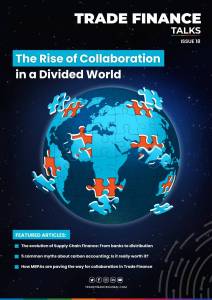There has been a dynamic shift in the financial ecosystem happening for several years now that many of us are not aware of. And that’s exactly the point.
Embedded finance is the term referring to the integration of financial services and products directly into the non-financial platforms, applications, or services that people already use in their daily lives.
Instead of accessing financial offerings through traditional standalone channels, embedded finance brings these services directly to the consumer within their existing interactions.
To learn about this hidden, but vital aspect of finance, Trade Finance Global’s Brian Canup (BC) spoke to Veronica Fernandez (VF), Senior Vice President and Regional Head of Visa Commercial Solutions for North America at Visa.
BC: Veronica, thanks for joining us! Could you please give a brief introduction for our readers? Who are you, and what is your background?
VF: My name is Veronica Fernandez. I manage Visa Commercial Solutions for North America.
Visa Commercial Solutions encompasses small business debit and credit, our large middle market business, our government business, and our B2B fintech partnerships business.
Before this role, I spent about four years on the merchant side of our business, where I oversaw the team responsible for managing our e-commerce and marketplace customer card-on-file relationships.
In that role, I experienced a lot of what was happening in embedded finance on the consumer side with ride-share apps, marketplaces, etc.
Those seamless experiences are what businesses of all sizes are looking for today.
Macrotrends in embedded finance
BC: Your previous roles have clearly given you a detailed understanding of this area. With this in mind, could you describe some of the macro trends that are driving embedded finance now in 2023?
VF: When I think about the world of embedded finance, what’s interesting to me is that we’ve actually been embedding finance for many, many years. Take for example, the retail and travel merchants, who are not banks, but use solutions like private label cards to offer financial services as one of the earliest forms of embedded finance.
But what we’ve seen unfold in recent years coming out of the pandemic, is a rapidly evolving digital economy which is necessitating the need for even more embedded finance and streamlined payment solutions.
That shift is something we like to refer to as the consumerisation of B2B payments. B2B clients are just like consumers – they are demanding faster, more seamless and efficient digital payment experiences. That’s really what’s driving embedded finance today – whether you’re a consumer looking to pay for gas using your vehicle or a business trying to pay your supplier with a virtual card while on business travel.
Another trend driving innovation and advancement in the embedded finance space is the growing ties between fintechs and financial institutions.
Financial institutions want to offer a differentiated product, and they want to get to market faster. We see them more open to partner with fintech’s than to build a solution from scratch, And fintech’s want the scale a financial institution can bring them.
BC: What were some of the key changes that led to this rapid development and adoption of embedded finance?
VF: Whether you’re a consumer or a business owner, we’re all looking to be able to do things in one place – and payments are no different. Think of our personal lives; we’ve all experienced a less-than ideal website where we’re redirected in order to complete one seemingly simple task. It’s an experience wrought with friction.
API infrastructure has been a game changer driving the growth of embedded finance. With the advent of API’s, they have made it much easier to integrate and provide features quickly, It drives that connectivity.

Building a ubiquitous digital experience
BC: How have consumer expectations shifted in terms of financial services and how is embedded finance helping to meet them?
VF: Today’s consumers expect a ubiquitous digital experience in nearly everything they do. Embedded finance has been making those payment experiences seamless, and it’s transforming things like distribution and access.
Let me highlight one example of embedded finance that takes distribution and access to new levels, streamlining both sides of a transaction – rideshare apps. On the consumer side, you can request and pay for a ride from directly within in an app. And on the driver’s side, driver’s can be paid to their card of choice enabling them to access their pay at the end of a shift versus waiting for a traditional pay cycle.
Another common example is using your mobile banking app to quickly send money as a gift or wedding present to a friend or cousin anywhere in the world, directly to their debit or virtual card.
Embedded finance blends those financial services seamlessly into customers’ daily activities and interactions with businesses.
Yes, consumer expectations have shifted, but embedded finance is helping meet those expectations.
And from a business perspective, using embedded finance or payments creates a stickier customer. Simply put, a happy customer will be loyal, which will drive long-term revenue to the business.
BC: What are some of the challenges that businesses and consumers face when adopting embedded finance? Some companies may struggle with the intricacies of digital adoption. How are they able to implement embedded finance?
VF: Some of the business challenges we see include integration problems, the need for program management support, and questions about building, selling, and servicing financial products. These challenges can demand substantial investment in technology and resources. However, there are companies that offer services like program management.
From a business challenge standpoint, data privacy and security are paramount. Embedding financial services into non-financial platforms can heighten data privacy and security concerns.
Another challenge that must be addressed is customer loyalty and trust. Do you have the type of customer that will trust you with their financial services?
It might be challenging for customers to make that leap versus working with traditional financial institutions, but I do think that customers are able to take bigger chances and get out of their comfort zone if you’re able to provide them with a seamless experience.
Making sure the experience is easy and flawless is most important.
The benefits of partnering with fintechs
BC: How can financial institutions benefit from partnering with certain brands and fintechs? But maybe look at this more from the brand’s point of view; how does that partnership work?
VF: Financial institutions can redefine their go-to-market strategy and leverage embedded finance to distribute services beyond their own capabilities and channels. Complementary partnerships with platforms that provide access to customer bases or new industry verticals can become a strong lever for financial institutions to scale non-direct channels and acquire new customers.
These collaborations between fintechs, FIs and distribution partners can help to offer banks and merchants turnkey services for delivery of embedded financial products.
Visa is at the forefront of these partnerships, with a unique network of networks strategy to drive growth. By expanding Visa’s embedded finance offerings and partnering with fintechs and platform providers across the value chain, Visa helps businesses and financial providers adapt to this new reality while unlocking new opportunities to drive growth in the digital economy.

Case studies – embedded payments
BC: Do you have any case studies for some of these topics you’ve mentioned?
VF: One recent example is with a European company called Weaver. which is like a plug-and-play specialist.
Weaver accelerates the adoption of embedded finance solutions among B2B SaaS companies. We’re working closely with them on the payment side as it relates to B2B software as a service (SaaS).
The future of embedded finance
BC: What can we anticipate for the future of embedded finance? I know trying to predict the future can be an impossible task, but if you had to give your best-educated guess, what will the next five to ten years look like?
VF: Businesses want to grow their offerings, offer digital payments options and increase engagement, and consumers want products and services that are easy to understand, use and pay for. Digital is really the future, and that’s what’s going to continue to drive the momentum.
One example of where we’re seeing embedded finance take off is within the fleet and fuel vertical. Both embedded payments and digital fleet cards can play a central role in the future development of vehicle fleets, as they help drive organisational efficiencies, and eliminate time-consuming manual processes. Our goal is to make fleet management more digitally accessible, enhance operational efficiency, and remove time-consuming manual tasks that aren’t feasible in an omnichannel environment like a phone.
I think we’re going to see continued collaboration and innovation from financial institutions, from fintechs, and from the networks to accelerate growth and innovation.















































